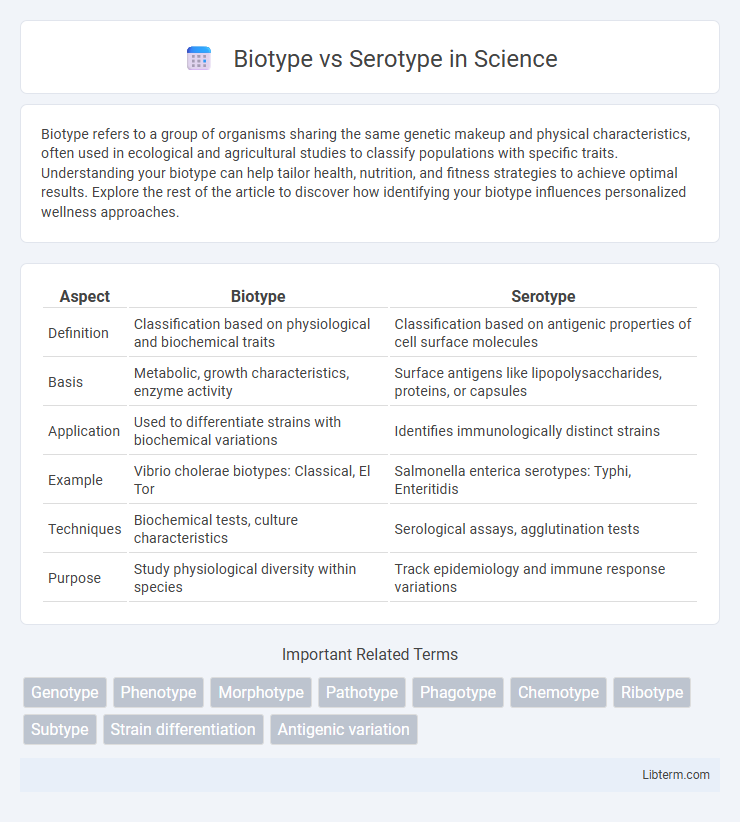Biotype refers to a group of organisms sharing the same genetic makeup and physical characteristics, often used in ecological and agricultural studies to classify populations with specific traits. Understanding your biotype can help tailor health, nutrition, and fitness strategies to achieve optimal results. Explore the rest of the article to discover how identifying your biotype influences personalized wellness approaches.
Table of Comparison
| Aspect | Biotype | Serotype |
|---|---|---|
| Definition | Classification based on physiological and biochemical traits | Classification based on antigenic properties of cell surface molecules |
| Basis | Metabolic, growth characteristics, enzyme activity | Surface antigens like lipopolysaccharides, proteins, or capsules |
| Application | Used to differentiate strains with biochemical variations | Identifies immunologically distinct strains |
| Example | Vibrio cholerae biotypes: Classical, El Tor | Salmonella enterica serotypes: Typhi, Enteritidis |
| Techniques | Biochemical tests, culture characteristics | Serological assays, agglutination tests |
| Purpose | Study physiological diversity within species | Track epidemiology and immune response variations |
Introduction to Biotype and Serotype
Biotype and serotype are critical classifications used in microbiology to differentiate bacterial strains based on genetic and antigenic properties, respectively. Biotypes categorize bacteria according to biochemical characteristics such as metabolism and enzyme activity, which influence their pathogenicity and ecological niche. Serotypes identify variations in surface antigens, primarily used in immunology to distinguish strains for vaccine development and epidemiological tracking.
Defining Biotype: Key Characteristics
Biotype classification is based on the physiological and biochemical properties of microorganisms, including their metabolic activities, enzyme production, and growth patterns under specific environmental conditions. Key characteristics defining a biotype encompass the organism's ability to ferment certain sugars, produce particular enzymes, and tolerate various temperature or pH levels. Unlike serotyping, which relies on antigenic structures detected by specific antibodies, biotyping emphasizes phenotypic traits that reflect functional attributes of the microorganism.
Defining Serotype: Key Characteristics
Serotype is defined by the distinct set of antigens found on the surface of bacteria or viruses, primarily determined through serological methods such as agglutination tests. These antigenic properties enable the classification of microorganisms into groups that share immunological characteristics, which is critical for identifying pathogens and guiding vaccine development. Unlike biotypes that rely on biochemical and physiological traits, serotypes specifically reflect variations in surface molecules that interact with the host immune system.
Biotype vs Serotype: Major Differences
Biotype and serotype are classification methods used in microbiology to distinguish bacterial strains based on different criteria; biotypes categorize bacteria according to biochemical and physiological properties, whereas serotypes classify bacteria based on distinct surface antigens detected by specific antibodies. Biotyping involves testing traits such as enzyme activity, sugar fermentation, and metabolic capabilities, providing insight into functional differences among strains, while serotyping targets variations in cell surface structures like lipopolysaccharides or capsules that trigger immune responses. These fundamental differences in classification criteria impact their applications in epidemiology, diagnostics, and vaccine development, with serotyping being crucial for tracking pathogen spread and biotyping aiding in understanding bacterial physiology and ecology.
Methods of Identifying Biotypes
Biotypes are identified primarily through phenotypic methods such as biochemical tests, metabolic profiling, and antimicrobial susceptibility patterns, which distinguish variations within a species based on physiological or biochemical traits. Techniques including MALDI-TOF mass spectrometry and genomic sequencing enhance the precision of biotype classification by analyzing protein expression or specific genetic markers. These methods contrast with serotype identification that relies on serological assays detecting distinct surface antigens.
Techniques for Serotyping
Serotyping techniques primarily rely on the detection of specific surface antigens using methods such as slide agglutination, enzyme-linked immunosorbent assay (ELISA), and molecular assays like polymerase chain reaction (PCR). Slide agglutination involves mixing bacterial samples with type-specific antisera to observe clumping reactions, confirming the serotype. PCR-based techniques enhance sensitivity and specificity by targeting genes encoding distinct serotype-specific antigens, enabling rapid and accurate serotype identification.
Applications in Microbiology and Medicine
Biotype classification identifies microorganisms based on physiological and biochemical characteristics, aiding in epidemiological tracking and targeted treatment strategies for infections. Serotype differentiation relies on detecting specific surface antigens, crucial for vaccine development and diagnosing diseases caused by pathogens such as Salmonella or Streptococcus. Both biotyping and serotyping enhance precision in microbial identification, improving clinical outcomes and public health interventions.
Importance in Disease Diagnosis
Biotype and serotype classification are crucial for precise disease diagnosis, as biotypes identify genetic and phenotypic variations within a species, guiding targeted treatment options. Serotypes, based on distinct surface antigens, enable accurate identification of pathogen strains, facilitating effective vaccine development and epidemiological tracking. Together, these classifications improve diagnostic accuracy and inform appropriate public health responses.
Biotype and Serotype in Epidemiological Studies
Biotype and serotype classifications play crucial roles in epidemiological studies by enabling the differentiation and tracking of microbial strains. Biotypes are categorized based on phenotypic characteristics such as metabolic activities and biochemical profiles, providing insight into microbial functionality and adaptability. Serotypes are distinguished through antigenic properties of cell surface structures, facilitating the identification of pathogen variations critical for outbreak investigations and vaccine development.
Future Trends in Microbial Classification
Future trends in microbial classification emphasize integrating biotype and serotype data with advanced genomic sequencing to enhance pathogen identification and disease tracking accuracy. Machine learning algorithms analyze phenotypic traits alongside serological markers, enabling rapid detection of emerging strains and antibiotic resistance patterns. This multi-dimensional approach supports precision medicine and public health interventions by fostering real-time surveillance and tailored antimicrobial therapies.
Biotype Infographic

 libterm.com
libterm.com